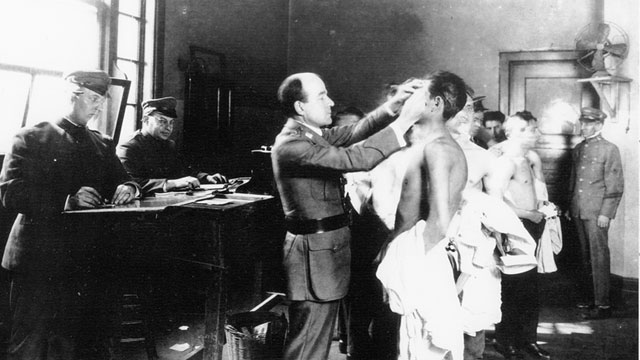Immigration Health Concerns
Different immigrants have different health concerns depending on their ethnicity. I found this topic extremely interesting due to my first assumption that typically, all immigrants would have the same or similar health concerns. Through research, I discovered how my original assumption was far from correct, which lead me to seriously rethinking my topic of health concerns. Before starting my initial research, I planned on primarily focusing on the immigration health process during the 1900's, and how that has developed compared to our time period. To my surprise, I found that the process has not changed that significantly. Similar to the 1900's, there continues to be a rigorous health inspection that assures you of not having any life threatening illness or habits, along with checking if you have received all of your vaccinations. Due to the topic not being as exciting as I planned because of the unexpected similarities between the time periods, I accidentally came across a some fascinating points from the website, annualreviews.org. This website demonstrated heavy proof that health concerns can differ depending on where the immigrant is coming from, and their ethnicity. I found this particularly interesting to read about and found a mass amount of information about the health of immigrants that I didn't have any idea about.
I first discovered how there are four different categories of immigrants in the US. First, there are legal immigrants, who have granted permission to enter to United States permanently or temporarily. Next, there are refugees, who are forces to flee his/her country because of persecution of was and is granted refugee status before entering the US. Then, similar to refugees, are the asylees, who are also forced to leave his/her country due to persecution of war. Unlike refugees however, asylee enter the United States without legal permission. Lastly there are undocumented immigrants, who do not have permission to be living in the United States and can be deported if found. These different immigration populations are greatly concentrated in 6 states, California, New York, Florida, Texas, New Jersey, and Illinois. Growth in these immigration populations has occurred over the past decade, leading to said immigrants being characterized poor, less educated, along with higher rates of unemployment. Mainly, the only exception to these stereotypes and generalizations can include of subgroup differences. Knowing this variation is crucial, for this variation has a heavy impact on data interpretation, collection, and success of interventions to improve health, that we will soon uncover is different for the variation of these cultural subgroups.
Upon research regarding these different subgroups of immigrants and their health concerns, I found that most immigrants have the same topics of health issues, but some immigrants are effected more than others. For example, popular leading health indicators while trying to become a legal citizen in the US are physical activity, and Tobacco use. First focussing on physical activity, I discovered that aspects of physical activity are important because it can lead to heart disease, diabetes, obesity, etc. Data on this topic states that immigrants are less likely to engage in regular exercise than the US born population. According to Commonwealth 2001 Healthcare Quality Survey, data also shows that immigrants are less likely to exercise regularly. 17% of immigrants reported to regular exercise vs the 21% of the US born population. While looking at ethnicity aspects, it was also reported that 16% foreign born hispanics never exercising compared to the 6% of US born, which goes to show how different ethnicities may act differently. With the other popular health concern being tobacco use, this still remains the leading cause of preventable morbidity and morality in the Unites States. 23% of the US population smokes regularly, and luckily, immigrants coming into the US usually smoke less. Significant variation on how social and cultural factors affect the initiation and use of tobacco is different for different immigrant communities. For example, Perez-Stable et al. found Central Americans to have lower smoking rates than other immigrants from Mexico or Cuba. South East Asian and Korean men have the highest smoking rates which can be anywhere between 34-43%, along African American immigrants who are only 7%. These data comparisons go to show you how these health concerns can have different effects on different people in multiple ways. This demonstrates how certain parts of this medical exam, along with health issues, can be harder on different subgroups of immigrants to pass.
Lastly, one other compelling subject of this topic was how the medical exam is actually completed. Typically, the examination is done by a civil surgeon, and will complete the form other known is form i693, to fill out the immigrants application. Firstly, the doctor will ask if you have received all of your necessary vaccinations, and proof that you have received them as well. Vaccinations that are required are as followed; mumps, measles, rubella, polio, tentanus, diphtheria, pertussis, type B influenza, herpatitis B, and pneumococcus. These required vaccinations are all just to ensure that no harmful diseases can come into the United States. After the necessary vaccination inspection is taken place, you will also get a review of your medical history along with other physical examinations such as a chest x-ray, blood tests, and a medical condition search. This medical condition search is also a carefully examined process, for this examination tests for any severe disorders that are harmful to the applicant, others, or property. This could also include of testing for harmful behavior history, or if such harmful behavior is likely to occur. After all of these tests have taken place, and the immigrant has successfully passed the inspection, the civil surgeon will deal the medical report with a stamp of approval and give it to the immigrant attorney. This immigrant attorney will take care of this medical file, and ensure that the immigrant can now live in the United States legally.
Through this research project. I have learned how ideas can change, along with how rigorous the process of becoming an immigrant is. Not only are there a mass amount of legal requirements, but fascinatingly, the process is not much different from what is was like over 100 years ago. This allowed me to make new discoveries of how the immigration process can be different for certain individuals. These factories further educated me on backgrounds of different immigrants, and how the health concerns can be different for different ethnicities, which contradicted my earlier understandings of how everyone has the same risks to the multiple health concerns further teaching me how and why this topic is important.
Here is a chart of the top ten countries of the foreign-born population in the year 2000. I found it very interesting to discover how these foreign-born individuals had different health concerns when compared to the US-born individuals

Here is an image of what it may look like to watch a doctor inspect an immigrant before allowing them come into the US.

Here is an image of what a medical inspection card may have looked like for immigrants in the 1900's. By looking closely, you can see the medical stamp of approval which was required for you to be able to enter the US.
Sources:

I like how you went through the entire process that is required and all the vaccinations that are needed
ReplyDeleteElla Jane, I liked how detailed your information was and how you showed that immigrants have a harder time dealing with health concerns than citizens, good job!
ReplyDeleteI enjoyed your blog on immigration health concerns. It was very informative and was interesting to hear the connections between countries. I liked learning about how immigrants are less likely to exercise and all the information on tobacco use.
ReplyDeleteI really found your article interesting! I thought it was really cool how there was little change between now and the 1900's in physical examinations. Some of your links did not work with the quotes or information, or were not hyperlinked. The percentages gave a lot of good information and gave a good view on populations sizes. Also, I would try to tie in the photos you use with the text as a way to allow people to see these gruesome and harsh pictures of the certificates and inspection. Very good!!!
ReplyDeleteI really enjoyed reading your post, and learned about what health areas officials look at the most when looking to admit immigrants. I thought the aspect of physical activity was especially interesting, and wondered what level of exercise is typically desired for admittance into the US?
ReplyDeleteI like that you address both stereotypes and facts and cultural differences in views of health.
ReplyDelete